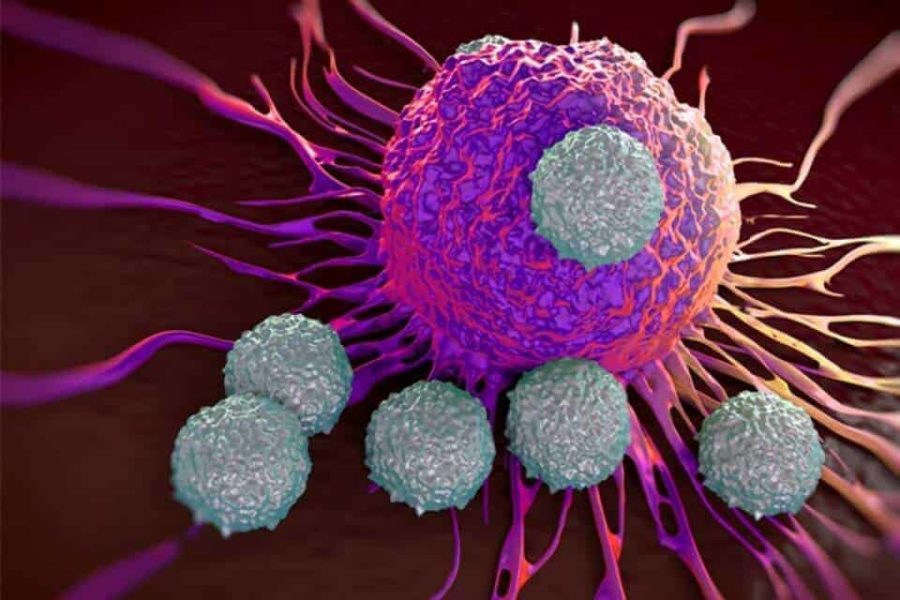In the battle against infections and diseases, from AIDS to cancer to diabetes, T-cells are the human body’s first line of defense.
The white blood cells act like soldiers searching out and destroying invading bacteria, viruses and parasites. Vital to our immune systems, T-cells not only find and kill infected cells, but also create antibodies, naturally eradicate cancer cells and remember germs our bodies encountered decades ago.
But even the strongest armies sometimes find themselves under siege.
When autoimmune diseases and viral infections attack our bodies, they thrive by targeting T-cells—either killing them, disrupting their performance or causing an imbalance in their ranks. With weakened or depleted T-cells, humans can be left virtually defenseless against potentially fatal assaults.
A new study led by Associate Professor of Physics Weiqun Peng may go a long way toward helping our natural defenders and reinforcing damaged T-cell systems.
In a paper published in the journal Nature Immunology, Dr. Peng, along with fourth-year Ph.D. student Zhouhao Zeng and immunologists from the University of Iowa, have unlocked part of the mystery behind T-cell identification—how individual T-cells determine what their functions will be.
The discovery is an important step toward designing drugs that can correct a depletion or imbalance of T-cells and may help the body’s defense against autoimmune diseases like AIDS.
“Many diseases operate by perturbing the balance between distinct types of T-cells,” Dr. Peng said. “By understanding how these cells are formed, we may, in theory, be able to manipulate T-cell creation and combat autoimmune diseases.”
Helpers and Killers
T-cells are broadly divided into two different categories: helper cells (also called CD4), which coordinate the immune response to invading infections, and killer cells (or CD8), which actually destroy infected cells to fight off illnesses.
Helper cells send out chemical messages, alerting the immune system that a virus has been detected. The helper cells instruct the killer cells to make copies of themselves, creating a CD8 army that seeks out and eliminates infected cells.
There are 25 million to one billion T-cells in the body. Humans need both helper and killer cells to maintain a healthy immune system.
A normal ratio is about one helper cell for every four killer cells. People with autoimmune diseases tend to have an increased helper cell to killer cell ratio, while those with viral infections have a decreased ratio.
Until now, researchers had yet to fully decipher what factors controlled the identity of T-cells—essentially how a cell “decided” whether it would be a helper or killer.
Dr. Peng’s team revealed that a complex interplay of proteins called transcription factors is the most vital component in establishing individual T-cell identity.
“Think of transcription factors as switches that turn ‘on’ or ‘off’ the genes in our cells,” Dr. Peng said.
Different kinds of cells have different transcription patterns (known as gene expression), making genes more or less active. In the case of T-cells, Dr. Peng’s research found that two specific transcription factors—called Tcf1 and Lef1—switched genes “on” and “off” in a pattern that maintained the identity of killer cells.
If that on/off pattern is disrupted, the cells instead become like helper cells. The researchers found that this feat depends on a previously unknown function of these transcription factors. They have intrinsic enzyme-related activities that can directly influence the epigenetic make-up of cells.
“This significant discovery is a new perspective on gene regulation,” said Mr. Zeng, who has worked on the T-cell project since 2014 as a research assistant in Dr. Peng’s lab.
“Obviously, CD4 and CD8 play important roles in our immune systems. If something goes wrong in the CD4/CD8 mix, our ability to fight off infections and diseases is compromised.
“But if biomedical scientists can develop strategies to turn on/off the T-cell differentiation pathway, we might be able to make drugs that hit the molecular target” and reinforce our immune systems.
A computational biophysicist, Dr. Peng’s role in the project involved analyzing the enormous troves of high-throughput sequencing data generated from experiments conducted by his University of Iowa counterparts. The results of their collaborative research came “as a complete surprise,” Dr. Peng said, since, according to conventional wisdom, transcription factors and epigenetic regulators were always thought to be separate entities.
After examining numerous scenarios, Dr. Peng concluded that Tcf1 and Lef1 were the unexpected determining factors that contain their own epigenetic regulators.
“There were no other options,” he said. “We eliminated all of the possible solutions. When you discount the possible, the only option left is the impossible—or at least what we once thought was impossible.”


